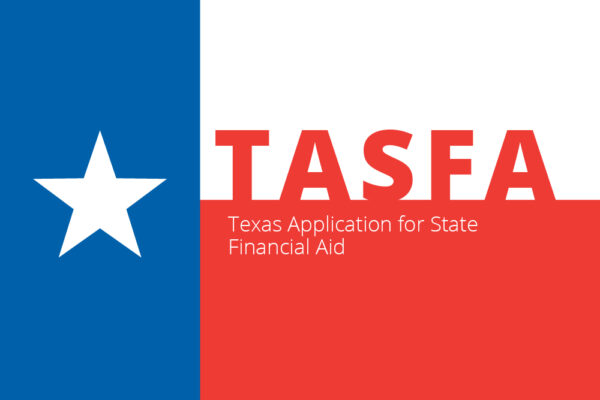Now that you understand the basics of paying for college, let’s explore how you can apply for state financial aid as a Texas Resident in TASFA 101.
What is It?
TASFA, Texas Application for State Financial Aid, is an application that students use to send their financial information and that of their parents to schools for them to determine how much aid the student qualifies for. Remember—the TASFA does not decide how much money you can get; the schools do. Therefore, it is crucial to apply to multiple schools to have more financial opportunities. Not every school will accept the TASFA; some schools prefer a paper FAFSA, so be sure to call or email the school’s financial aid office before sending a TASFA.
Who is Eligible?
Students who are not eligible for Federal Aid but are residents of Texas are eligible for state aid and may submit a TASFA. You will not need to fill out both a FAFSA and a TASFA for the same school.
- To be considered a Texas resident and to qualify for state aid, students must meet these requirements:
- Reside in Texas 12 months prior to enrollment in a higher education institution.
- Graduate from a Texas High School or obtain a GED in Texas.
- Have lived in Texas for 36 months prior to high school graduation.
- Sign an Affidavit of Intent to become a permanent resident. This must also be officially notarized.
Why do I File the TASFA?
The TASFA is how institutions determine how much state financial aid students are eligible to receive. Students who submit a TASFA are not eligible for federal financial aid programs such as the Federal Pell Grant, Federal Work-Study Program, or Federal Direct Loans. However, Texas does offer several State Grants and Scholarships that students may receive by submitting a TASFA. You can find a list of the Types of State Grants and Scholarships on the College For All Texans website.
How do I Submit the TASFA?
Step 1: Get the TASFA Application
The TASFA can be found at collegeforalltexans.com. The TASFA is free; it doesn’t cost anything to complete one!
Print off a copy of the TASFA or complete the form online. There are versions in English and Spanish, and with or without instructions. The version with instructions is very helpful when completing a TASFA for the first time. If possible, get together with your high school counselor, financial aid advisor, or College Possible Coach when completing your TASFA.
Step 2: Gather Required Documents
The following documents are required by colleges and universities along with the TASFA. It is recommended to send all documents together at the same time.
Parents:
- W2’s or W7’s
- Tax Return (IRS 1040,1040A,1040EZ)
- Your tax transcript from the IRS
- Verification Worksheet provided by the school (call your school’s financial aid office if you cannot find the worksheet online)
Students:
- W2’s or W7’s (if employed)
- Tax return (if employed)
- Complete a TASFA for every school
- A notarized affidavit of intent to become a permanent resident
- Some schools require documentation (usually just a worksheet they sign) if they did not file taxes
- If you earned under $12,950, you are not required to file taxes
Step 3: Mail Necessary Items (if you’re unable to complete the TASFA online)
After completing your TASFA form, a signed copy of the TASFA and all supplemental documents will need to be mailed to each school where you have applied or plan to apply.
- Each envelope must contain:
- Completed TASFA Application
- Copies of W-2
- Prior-prior year tax return transcript (students/ parents)
- Can be obtained from the IRS here
- Selective Service Card (males only) 1-888-655-1825 or www.sss.gov
- Notarized and signed Affidavit of Intent to Become a Permanent Resident (can be obtained from Registrar’s Office)
Please note you do not have to pay in order to file your TASFA.
- For the 2023-2024 academic year, you will need the tax information from the income you received in 2021.
- For the 2024-2025 academic year, you will need the tax information from the income you received in 2022.
Verification
Verification refers to the process that schools use to confirm that the information provided on your FAFSA or TASFA is accurate. Students who are selected for verification will need to complete additional documentation in order for their financial aid application to be processed. The additional documentation may include submitting your tax return transcript or letter of non-filing from the IRS, completing a household size, income verification, or state residency worksheet, or it may involve completing documentation to verify that you are able to apply for financial aid as an independent student.
After submitting your TASFA, be sure to contact the school and check your student portal frequently to ensure that they have all of the information they need from you. You will not be awarded financial aid until all verification materials have been submitted.
Talking to Your Parents About TASFA
Free money is available to students who qualify, and Institutions do not share citizenship status information with other government agencies.
- The IRS does not share citizenship status information with other government agencies.
- Parents and students must file taxes in order to be eligible for state financial aid.
- For the 2023-2024 academic year, you will need the tax information from the income you received in 2021.
- For the 2024-2025 academic year, you will need the tax information from the income you received in 2022.
It is important to file the TASFA as soon as possible because it takes longer to process than the FAFSA, and there are fewer state grant funds available than federal funds.
Next Steps
If you do not qualify for federal student aid through the FAFSA, but you do meet Texas state residency requirements, then you may be eligible to receive state financial aid by submitting a TASFA. Now that you know how to apply for the financial aid that you are eligible for, let’s review how to apply to college.



